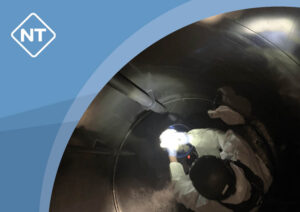The operators of foam-based extinguishing systems are currently faced with strict PFC/PFAS ban regulations that have a major impact on their industry. The reduced limits have led to an urgent need: the cleaning and decontamination of foam tanks down to the nanogram range. Many experts recommend demolishing and rebuilding these systems, but is that really the only solution? We say no. A thorough and environmentally friendly decontamination of foam-specific tanks is possible, and NT Service GmbH is your competent partner for this demanding process.
Our expertise is based on years of experience and numerous expert reports that prove residue-free decontamination beyond doubt. External laboratory analyses after decontamination play a crucial role in confirming the effectiveness of our process.
We always stay up to date with the latest legislation and provide plant operators with comprehensive and correct information, even with regard to PFC substances that are not yet banned but could potentially fall under the ban in the future.
At NT Service GmbH, you can rely on an experienced team of specialists who specialize in the specific requirements of decontamination of foam agent tanks containing PFC/PFAS. Our know-how and practical experience ensure thorough and efficient cleaning of your system, in strict compliance with all applicable regulations and guidelines.
Our services go beyond decontamination. We also offer comprehensive analysis of foam agent samples in cooperation with external laboratories. This provides you with reliable data on the level of contamination in your tank system. After careful data analysis, we take responsibility for cleaning your tank system in an environmentally friendly manner.
NT Service GmbH has earned a reputation for outstanding results. We were able to detect residues of 200 to 400 μg in GRP tanks, PE tanks and fittings, starting from an initial value of over 1000 μg. Our methods ensure thorough decontamination of your tank system, which meets both legal requirements and ecological standards.
We understand the responsibility that plant operators have to prevent environmental contamination. That’s why we work closely with the relevant authorities and can provide you with contact points where you can get further assistance.
If your sprinkler company or foam manufacturer has informed you that your foam concentrate is not permitted, please do not hesitate to contact us. Our experts will be happy to answer any questions you may have, free of charge and without obligation, and can also advise you on site if required. We offer customized solutions that are precisely tailored to the individual needs of your company. Rely on NT Service GmbH for effective and environmentally friendly decontamination of your foam agent tanks.
NT Service GmbH relies on innovative approaches to carry out the decontamination of foam agent tanks containing PFC/PFAS at the highest level. Our experts use state-of-the-art technologies and processes to ensure that even the smallest residues in your tanks are effectively removed. Here are some of the key aspects of our services:
- Highest precision in the nanogram range: We are proud that our decontamination processes reach down to the nanogram range. This means that even the tiniest PFC/PFAS residues are removed from your foam concentrate tanks. Our precise analysis methods and cleaning techniques are designed to ensure absolute cleanliness.
- Environmental compatibility: Environmental compatibility is of the utmost importance to us. We use environmentally friendly cleaning agents and technologies to ensure that no harmful substances are released into the environment. Our processes are designed to meet ecological standards while ensuring maximum efficiency.
- Cooperation with authorities: We have close relationships with the relevant environmental authorities and work closely with them to ensure that your decontamination complies with legal requirements. We take our responsibilities seriously and are here to help you comply with the regulations.
- Customized solutions: Every foam concentrate tank system is unique, and we understand that your requirements are specific. Our experts develop customized solutions that are tailored to your company’s individual needs. We take your operations into account and work closely with you to ensure that decontamination runs smoothly.
- Transparent communication: We attach great importance to clear and transparent communication. Our experts are available throughout the process to answer your questions and keep you informed about the progress of the decontamination.
In short, NT Service GmbH is the trusted partner you can rely on for the decontamination of PFC/PFAS-containing foam agent tanks. Our experience, expertise and commitment to environmental sustainability ensure that your tank installations meet the highest standards. Contact us today for more information on our services and to work together to find a solution that meets your needs. Your tank system deserves the best care, and we’re here to make sure it gets just that.
In 2021, EU Regulation 2021/1297 regulated the use of C9-C14 PFCAs (perfluorinated carboxylic acids with 9 to 14 carbon atoms) in foaming agents, including their salts and related substances. This ban has so far received little attention, although these long-chain PFAS can occur in foaming agents in the same way as PFOA. The EU Commission has set limit values:
- Sum of C9-C14 PFCA and their salts: 25ppb (0.025mg/kg)
- Sum of C9-C14 PFCA-related substances: 260ppb (0.26mg/kg)
These values are lower than most limit values for PFAS. For details on selecting the relevant limit value, please refer to our article on PFAS analysis of foaming agents. Transitional regulations also apply:
- Production and sale: Permitted until February 25, 2023
- Storage at end users: Permitted until July 4, 2025 (under certain restrictions)
- Foam concentrate in the tank of fire engines and extinguishing systems: Permitted until December 31, 2022, thereafter until July 4, 2025, if the extinguishing water can be collected
- Educational purposes: Prohibited since August 25, 2021
- Tests (to check the technology): Permitted until July 4, 2025, if the extinguishing water is completely collected and disposed of properly
However, these transitional regulations only apply to class B foam concentrates.
The ban on PFHxS in foaming agents
EU Regulation 2023/1608, published on May 30, 2023, implements the ban on perfluorohexanesulfonic acid (PFHxS) in foaming agents. PFHxS is the latest representative of per- and polyfluorinated alkyl compounds (PFAS) to be banned in Europe. The limit value for PFHxS in foaming agents is 100µg/kg (100ppb) for PFHxS, its salts and related compounds. This value will be reviewed again by the EU Commission in 2026. PFHxS does occur in foaming agents, but usually in small quantities.
Which foam concentrates contain PFAS?
There are three main types of foaming agents that may contain PFAS:
- AFFF (Aqueous Film Forming Foam): This is the most common fluorine-containing foam and is often used synonymously with PFAS-containing foaming agents.
- FFFP foaming agents (Film Forming Fluoroprotein): These foaming agents also form a water film, but do not contain any synthetic surfactants.
- FP (fluoroprotein): These foam concentrates were the first fluorinated foam concentrates and absorb less fuel to increase efficiency.
However, it is difficult to predict which PFAS are present in which concentrations in a particular foam concentrate. With existing foam concentrate stocks, the ingredients can vary greatly, as mixing and contamination can occur. Laboratory tests are necessary to determine the PFAS content in a foam concentrate.
Future regulation of PFAS in foaming agents
The regulation of PFAS is an ongoing process. There are ongoing initiatives to regulate other PFAS compounds in foaming agents, including perfluorohexanoic acid (PFHxA) and long-chain perfluorocarboxylic acids (LC PFCA). The regulation of PFAS as a whole group in foaming agents is also being considered. However, the exact regulations and deadlines may still change. It is important to keep an eye on these developments as they may further restrict the use of PFAS in foaming agents.






